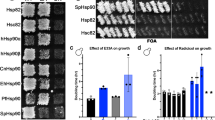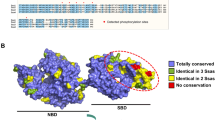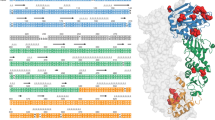Abstract
The budding yeast Saccharomyces cerevisiae has two HSP90-related genes per haploid genome, HSP82 and HSC82. Random mutations were induced in vitro in the HSP82 gene by treatment of the plasmid with hydroxylamine. Four temperature-sensitive (ts) mutants and one simultaneously is and cold-sensitivie (cs) mutant were then selected in a yeast strain in which HSC82 had previously been disrupted. The mutants were found to have single base changes in the coding region, which caused single amino acid substitutions in the HSP82 protein. All of these mutations occurred in amino acid residues that are well conserved among HSP90-related proteins of various species from Escherichia coli to human. Various properties including cell morphology, macromolecular syntheses and thermosensitivity were examined in each mutant at both the permissive and nonpermissive temperatures. The mutations in HSP82 caused pleiotropic effects on these properties although the phenotypes exhibited at the nonpermissive temperature varied among the mutants.
Similar content being viewed by others
References
Adams EMA, Pringle JR (1984) Relationship of actin and tubulin distribution to bud growth in wild-type and morphogeneticmutant Saccharomyces cerevisiae. J Cell Biol 98:934–945
Ang D, Liberek K, Skowyra D, Zylicz M, Georgopoulos C (1991) Biological role and regulation of the universally conserved heat shock proteins. J Biol Chem 266:24233–24236
Bardwell A, Craig E (1987) Eucaryotic Mr 83,000 heat shock protein has a homologue in Escherichia coli. Proc Natl Acad Sci USA 84:5177–5181
Becker DM, Guarente L (1991) High efficiency electroporation. Meth Enzymol 194:182–186
Borkovich K, Farrelly R, Finkelstein D, Taulien J, Lindquist S (1989) HSP82 is an essential protein that is required in higher concentrations for growth of cells at higher temperatures. Mol Cell Biol 9:3919–3930
Brugge JS, Erickson E, Erickson RL (1981) The specific interaction of the Rous sarcoma virus transforming protein, pp60src, with two cellular proteins. Cell 25:363–372
Catelli M, Binart N, Jung-Testas I, Renoir J, Baulieu E, Feramisco J, Welch W (1985) The common 90-kd protein component of non-transformed ‘8S’ steroid receptors is a heat-shock protein. EMBO J 4:3131–3135
Craig EA, Jacobsen K (1984) Mutations of the heat inducible 70 kilodalton genes of yeast confer temperature sensitive growth. Cell 38:841–849
Craig EA, Kramer J, Kosic-Smithers J (1987) SSCI, a member of the 70-kDa heat shock protein multigene family of Saccharomyces cerevisiae, is essential for growth. Proc Natl Acad Sci USA 84:4156–4160
Csermely P, Kahn CR (1991) The 90-kDa heat shock protein (hsp-90) possesses an ATP binding site and autophosphorylating activity. J Biol Chem 266:4943–4950
Deshaies R, Koch B, Werner-Washburne M, Craig E, Schekman R (1988) A subfamily of stress proteins faciliates translocation of secretory and mitochondrial precursor polypeptides. Nature 332:800–805
Dragon E, Sias S, Kato E, Gabe J (1987) The genome of Trypanosoma cruzi contains a constitutively expressed, tandemly arranged multicopy gene homologous to a major heat shock protein. Mol Cell Biol 7:1271–1275
Farrelly F, Finkelstein D (1984) Complete sequence of the heat shock-inducible HSP90 gene of Saccharomyces cerevisiae. J Biol Chem 9:5745–5751
Finkelstein D, Strausberg S (1983) Identification and expression of a cloned yeast heat shock gene. J Biol Chem 258:1906–1913
Finley D, Ozkaynak E, Varshavsky A (1987) The yeast polyubiquitin gene is essential for resistance to high temperatures, starvation, and other stresses. Cell 48:1035–1046
Gething M-J, Sambrook J (1992) Protein folding in the cell. Nature 355:33–45
Hutter KJ, Eipel HE (1979) Microbial determinations by flow cytometry. J Gen Microbial 113:369–375
Iida H, Yahara I (1984) Specific early-G blocks accompanied with stringent response in Saccharomyces cerevisiae lead to growth arrest in resting state similar to the G0 of higher eucaryotes. J Cell Biol 98:1185–1193
Joab I, Radanyi C, Renoir M, Buchou T, Catelli MG, Binart N, Mester J, Banlien E-E (1984) Common non-hormone binding component in non-transformed chick oviduct receptors of four steroid hormones. Nature 308:850–853
Johnston G, Singer R (1980) Ribosomal precursor RNA metabolism and cell division in the yeast Saccharomyces cerevisiae. Mol Gen Genet 178:357–360
Koyasu S, Nishida E, Kadowaki T, Matsuzaki F, Iida K, Harada F, Kasuga M, Yahara I (1986) Two mammalian heat shock proteins, HSP90 and HSP100 are actin-binding proteins. Proc Natl Acad Sci USA 83:8054–8058
Lindquist S (1986) The heat-shock response. Annu Rev Biochem 55:1151–1191
Lindquist S, Craig E (1988) The heat-shock proteins. Annu Rev Genet 22:631–677
Minami Y, Kawasaki H, Miyata Y, Suzuki K, Yahara I (1991) Analysis of native forms and their isoform compositions of the mouse 90-kDa heat shock protein, HSP90. J Biol Chem 266:10099–10103
Minami Y, Kawasaki H, Suzuki K, Yahara I (1993) The calmodulin-binding domain of the mouse 90-kDa heat shock protein. J Biol Chem 268:9604–9610
Miyata Y, Yahara I (1992) The 90-kDa heat shock protein, HSP90, binds and protects casein kinase II from self-aggregation and enhances its kinase activity. J Biol Chem 267:7042–7047
Oppermann H, Levinson W, Bishop M (1981) A cellular protein that associates with the transforming protein of Rous sarcoma virus is also a heat-shock protein. Proc Natl Acad Sci USA 78:1067–1071
Parsell AD, Sanchez Y, Stitzel JD, Lindquist S (1991) Hsp104 is a highly conserved protein with two essential nucleotide-binding sites. Nature 353:270–273
Picard D, Khursheed B, Garabedian MJ, Fortin MG, Lindquist S, Yamamoto KR (1990) Reduced levels of. HSP90 compromise steroid receptor action in vivo. Nature 348:166–168
Rebbe FN, Ware J, Bertina RM, Modrich P, Stafford W (1987) Nucleotide sequence of a cDNA for a member of the human 90-kDa heat-shock protein family. Gene 53:235–245
Sanchez ER, Meshinchi S, Tienrungroj W, Schlesinger MJ, Toft DO, Pratt WB (1987) Relationship of the 90 kDa murine heat shock protein to the untransformed and transformed states of the glucocarticoid receptor. J Biol Chem 262:6986–6991
Sanchez Y, Tanlien J, Barkovich KA, Lindquist S (1992) Hsp104 is required for tolerance to many forms of stress. EMBO J 11:2357–2364
Schauer I, Emer S, Gross C, Schekman R (1985) Invertase signal and mature sequence substitutions that delay intercompartmental transport of active enzyme. J Cell Biol 100: 1664–1675
Schlesinger MJ (1990) Heat shock proteins. J Biol Chem 265:12111–12114
Sherman F, Fink GR, Hicks JB (1983) Methods in yeast genetics. Cold Spring Harbor Laboratory Press, Cold Spring Harbor, NY
Sikorski R, Hieter P (1989) A system of shuttle vectors and yeast host strains designed for efficient manipulation of DNA in Saccharomyces cerevisiae. Genetics 122:19–27
Werner-Washburne M, Stone DE, Craig EA (1987) Complex interactions among members of an essential subfamily of hsp70 genes in Saccharomyces cerevisiae. Mol Cell Biol 7:2568–2577
Yahara I, Iida H, Koyasu S (1986) A heat shock-resistant variant of Chinese hamster cell line constitutively expressing heat shock protein of Mr 90,000 at high level. Cell Struct Funct 11:65–73
Author information
Authors and Affiliations
Additional information
Communicated by K. Isono
Rights and permissions
About this article
Cite this article
Kimura, Y., Matsumoto, S. & Yahara, I. Temperature-sensitive mutants of hsp82 of the budding yeast Saccharomyces cerevisiae . Molec. Gen. Genet. 242, 517–527 (1994). https://doi.org/10.1007/BF00285275
Received:
Accepted:
Issue Date:
DOI: https://doi.org/10.1007/BF00285275




